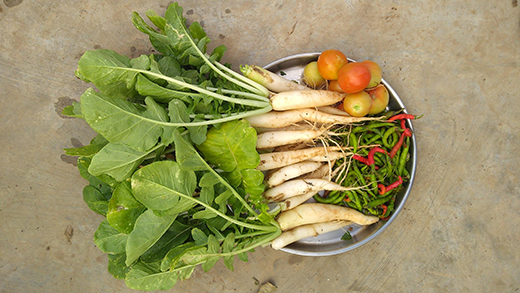
Horseradish should be harvested when the leaves have died back due to frost.
In the Garden: Now is the time to harvest horseradish
Horseradish spreads quickly, so harvesting it each year is important, says Domenghini
Nov. 9, 2023
By Maddy Rohr, K-State Research and Extension news service
MANHATTAN, Kan. — A Kansas State University horticulture expert says gardeners should be keeping close watch on the weather before harvesting a root vegetable that packs quite the bite.
Cynthia Domenghini said horseradish grows a substantial amount at the end of summer and early fall, but harvest should be delayed until just before the ground freezes in November or December. Domenghini said horseradish is a perennial plant, but is most commonly grown as an annual and harvested when the leaves have died back from frost.
“To harvest horseradish, dig a trench alongside the row of plants exposing the roots. Use a shovel or pull the plants by hand toward the trench releasing them from the soil,” Domenghini said.
Next, she said, remove the foliage, leaving about one inch above the crown and remove smaller, side roots. Collect the larger roots for storage. Domenghini said smaller roots can be cut into 6-8 inch long sections and planted now for next year’s crop.
“You may choose to leave horseradish roots in the ground until spring,” Domenghini said. “Apply a thick layer of mulch to prevent the ground from freezing and harvest as needed.”
Domenghini warned that horseradish can easily spread throughout the garden if not contained, so harvesting it each year is important.
After harvesting, wash the roots thoroughly and dry before storing in plastic bags in the refrigerator.
“When preparing horseradish, peel the roots and cut into sections,” Domenghini said. “Blend the root pieces along with a little water and a couple of ice cubes.”
When horseradish is blended it releases oils with strong fumes that can be an irritant.
“This is what gives horseradish the strong flavor, but use caution when opening the blender to avoid getting it into your eyes,” Domenghini said.
She suggests incorporating vinegar immediately after blending the horseradish to stop the reaction and make the horseradish milder.
“Wait a few minutes to add the vinegar if you want a stronger flavor,” Domenghini said. “Two to three tablespoons of vinegar per cup of horseradish is sufficient.”
Domenghini and her colleagues in K-State's Department of Horticulture and Natural Resources produce a weekly Horticulture Newsletter with tips for maintaining home landscapes and gardens. The newsletter is available to view online or can be delivered by email each week.
Interested persons can also send their garden and yard-related questions to Domenghini at cdom@ksu.edu, or contact your local K-State Research and Extension office.

